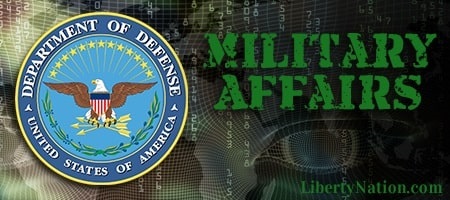Haven’t we seen this movie before?
The Defense Department is considering sending more military advisers to Ukraine. For many, it will come as a surprise that America already has advisers on the ground in that war-zone. With the US Senate passing a $95 billion foreign aid package yesterday, April 23, it is not just American cash that will be supporting the war effort. In what some believe is a further demonstration of commitment, the Pentagon intends to dispatch military service members to Kyiv. While these troops will be working out of the embassy and providing guidance, they will not be in combat. The incremental insertion, however, is sparking fears that the government is engaging in a 1950s approach all over again.

There is a precedent that the US has a propensity to ease itself into wars. Obviously, the most historically prominent example is the buildup of US military forces in Vietnam. Liberty Nation described the slippery slope back in September last year: “President Kennedy’s term saw 16,300 soldiers, Marines, airmen, and sailors involved in the country by the end of 1963. That number reached its zenith in 1968 at a whopping 536,100 under President Lyndon Johnson’s administration.” Now, we are seeing the same inclination on the part of the Pentagon emerging.
Plans Afoot to Send More US Troops to Ukraine
A recent report by Voice of America describes planning by the US Defense Department to deploy an unknown number – but as many as 60 advisers – to the US Embassy in Kyiv. However, speaking to VOA, the Pentagon press secretary, Air Force Major General Pat Ryder, stated, “Throughout this conflict, the [Department of Defense] has reviewed and adjusted our presence in-country as security conditions have evolved. Currently, we are considering sending several additional advisers to augment the Office of Defense Cooperation at the embassy.” The ODC is the organization that administers all US military assistance to foreign countries.
 Though Ryder was very quick to explain any additional advisers would be in a “non-combat” role, circumstances and location can rapidly modify such position. Furthermore, with the Biden administration’s abject dread of being perceived as escalating the level of the conflict in Ukraine, increasing the US military’s boots on the ground, regardless of the role, could be viewed by Russia’s President Vladimir Putin as direct US engagement in the conflict. The fact that the advisers have only administrative responsibilities may be a distinction without a difference. Putin has in the past used any pretext for threatening to broaden Moscow’s objectives in the Ukraine battle space. Politico described the initiative to increase the military contingent in Ukraine:
Though Ryder was very quick to explain any additional advisers would be in a “non-combat” role, circumstances and location can rapidly modify such position. Furthermore, with the Biden administration’s abject dread of being perceived as escalating the level of the conflict in Ukraine, increasing the US military’s boots on the ground, regardless of the role, could be viewed by Russia’s President Vladimir Putin as direct US engagement in the conflict. The fact that the advisers have only administrative responsibilities may be a distinction without a difference. Putin has in the past used any pretext for threatening to broaden Moscow’s objectives in the Ukraine battle space. Politico described the initiative to increase the military contingent in Ukraine:
“President Joe Biden has long vowed US troops wouldn’t participate in the war on Ukraine’s behalf, as doing so would increase the risk of a direct confrontation between American and Russian forces…One of the tasks the advisers will tackle is helping the Ukrainians plan sustainment of complex equipment donated by the US as the summer fighting is expected to ramp up…”
When sustaining complex equipment takes place in the field, keeping a distance from combat may be a challenge. While the US is considering the level of service members supporting Kyiv, others, seeing Russia’s growing threat to Europe, believe a more robust European response might soon be warranted. The failure of the Biden national security team to explain its strategy for concluding the violence in Ukraine, coupled with a drawn-out process to provide military aid, has had a chilling effect on NATO and European allies’ expectations of America. Recent statements by French President Emmanuel Macron hinting at a favorable disposition toward European military boots on the ground in Ukraine suggest a change in thinking about direct military assistance to Kyiv. In its assessment of the option for European intervention in Ukraine, Foreign Affairs analysts were not subtle.
One Option: European Troops on the Ground
“The Baltic states are in danger, as is Poland: last year, the former Russian prime minister and Putin loyalist Dmitri Medvedev described the Baltics as ‘our’ (meaning Russian) provinces and Poland as ‘temporarily occupied’ (meaning by NATO,)” Foreign Affairs explained. Additionally, the authors warned that Europe could not rely on “American political dysfunction” to defend Europe. Consequently, the way ahead for the Council on Foreign Relations journal writers is clear. “They [Europeans] must seriously contemplate deploying troops to Ukraine to provide logistical support and training, to protect Ukraine’s borders and critical infrastructure, or even to defend Ukrainian cities,” the authors conclude.
The bravado of academic musings within national security think tanks may appeal to some – still, there is little evidence of an overwhelming enthusiasm among European nations to make boots on the ground in Ukraine a reality. However, it appears there are two approaches to dealing with Ukraine gaining traction. The Biden approach is oozing into war incrementally with no strategy or objective. It’s happened before. Then there is what the Council on Foreign Relations offers: Europeans, with or without the US, jumping into Ukraine with both boots, so to speak. What is clear is that, eventually, there has to be a light at the end of the Ukraine conflict tunnel – and it can’t be a Russian train.
~
The views expressed are those of the author and not of any other affiliate.

